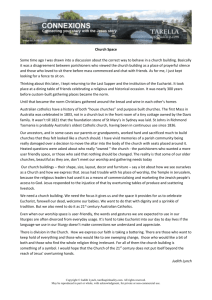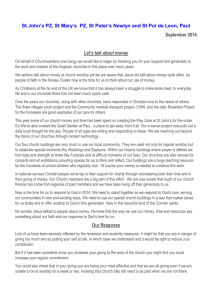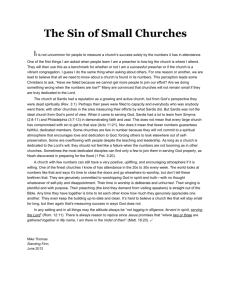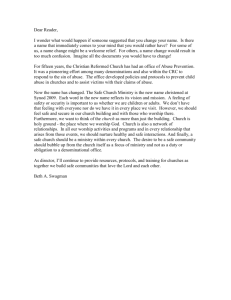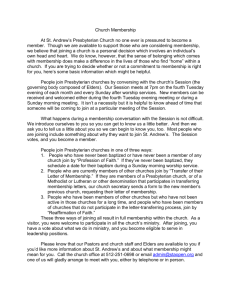Articles - Reflections upon the Use of Tangible Images in the
advertisement
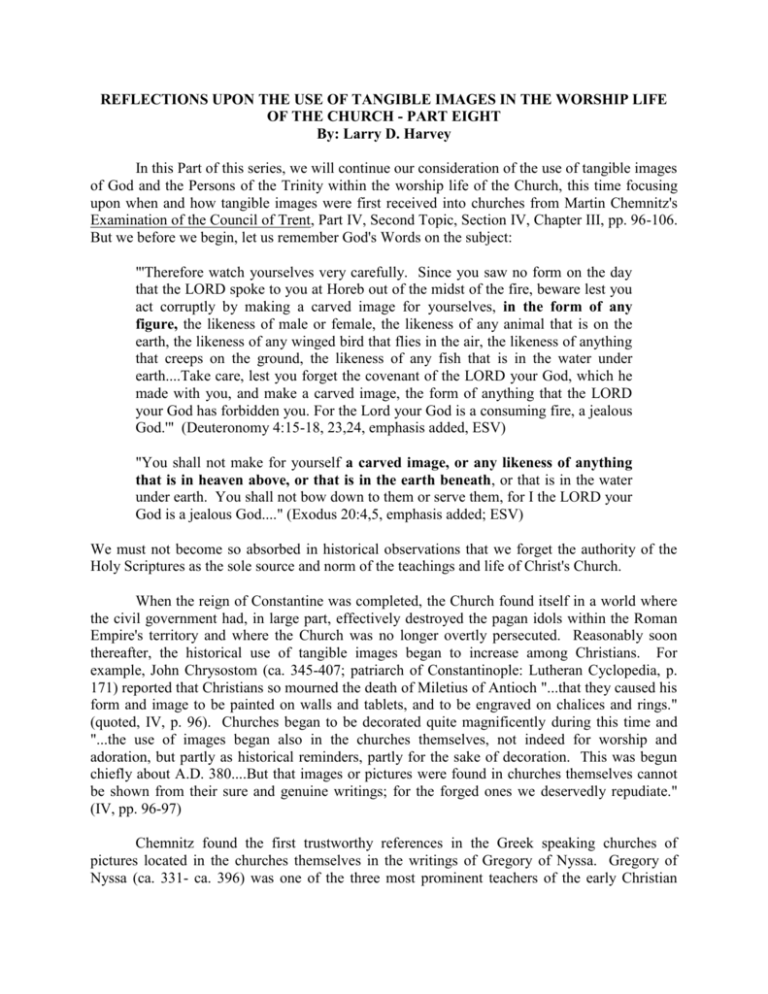
REFLECTIONS UPON THE USE OF TANGIBLE IMAGES IN THE WORSHIP LIFE OF THE CHURCH - PART EIGHT By: Larry D. Harvey In this Part of this series, we will continue our consideration of the use of tangible images of God and the Persons of the Trinity within the worship life of the Church, this time focusing upon when and how tangible images were first received into churches from Martin Chemnitz's Examination of the Council of Trent, Part IV, Second Topic, Section IV, Chapter III, pp. 96-106. But we before we begin, let us remember God's Words on the subject: "'Therefore watch yourselves very carefully. Since you saw no form on the day that the LORD spoke to you at Horeb out of the midst of the fire, beware lest you act corruptly by making a carved image for yourselves, in the form of any figure, the likeness of male or female, the likeness of any animal that is on the earth, the likeness of any winged bird that flies in the air, the likeness of anything that creeps on the ground, the likeness of any fish that is in the water under earth....Take care, lest you forget the covenant of the LORD your God, which he made with you, and make a carved image, the form of anything that the LORD your God has forbidden you. For the Lord your God is a consuming fire, a jealous God.'" (Deuteronomy 4:15-18, 23,24, emphasis added, ESV) "You shall not make for yourself a carved image, or any likeness of anything that is in heaven above, or that is in the earth beneath, or that is in the water under earth. You shall not bow down to them or serve them, for I the LORD your God is a jealous God...." (Exodus 20:4,5, emphasis added; ESV) We must not become so absorbed in historical observations that we forget the authority of the Holy Scriptures as the sole source and norm of the teachings and life of Christ's Church. When the reign of Constantine was completed, the Church found itself in a world where the civil government had, in large part, effectively destroyed the pagan idols within the Roman Empire's territory and where the Church was no longer overtly persecuted. Reasonably soon thereafter, the historical use of tangible images began to increase among Christians. For example, John Chrysostom (ca. 345-407; patriarch of Constantinople: Lutheran Cyclopedia, p. 171) reported that Christians so mourned the death of Miletius of Antioch "...that they caused his form and image to be painted on walls and tablets, and to be engraved on chalices and rings." (quoted, IV, p. 96). Churches began to be decorated quite magnificently during this time and "...the use of images began also in the churches themselves, not indeed for worship and adoration, but partly as historical reminders, partly for the sake of decoration. This was begun chiefly about A.D. 380....But that images or pictures were found in churches themselves cannot be shown from their sure and genuine writings; for the forged ones we deservedly repudiate." (IV, pp. 96-97) Chemnitz found the first trustworthy references in the Greek speaking churches of pictures located in the churches themselves in the writings of Gregory of Nyssa. Gregory of Nyssa (ca. 331- ca. 396) was one of the three most prominent teachers of the early Christian Church who worked in Cappadocia in the Fourth Century A.D. He, along with Basil the Great and Gregory of Nazianzus, championed the confession of the faith of Nicaea and brought the work of Athanasius to "...a climax. The virtual defeat of Arianism at the Second Ecumenical Council in Constantinople 381 was largely due to their efforts." (Lutheran Cyclopedia, p. 135, see also p. 350) Gregory of Nyssa describes the memorials of martyrs and includes references to specific paintings of the martyr Theodore and of the history of Abraham preparing to kill Isaac with language such as "These things the painter, as though speaking in a book, depicted artistically...For also a picture, hanging silently on a wall, is accustomed to speak to us and to do much good...." (quoted IV, p.97) Among the Latin speaking churches, Chemnitz references writings about Pontius Paulinus "...who lived after A.D. 400, that when the people who assembled on the birthday [the anniversary of a martyr's death] of blessed Felix were accustomed to feast in the church, Paulinus saw to it that the walls of the church were decorated with pictures of the Old and New Testament, in order that those who reclined at table, being occupied and looking at these, might conduct their meal more temperately." (IV, p. 97) Chemnitz describes other pictures concerning depictions of the Trinity, martyrs, and departed saints in those same early Latin speaking churches. "One gathers...that later the sign of the cross was also brought into the church. For when Olympiodorus had asked whether it would proper to decorate the church with pictures of various living things, he [Nilus (died ca. A.D.430: Lutheran Cyclopedia, p. 578)] answers that this is childish and foolish, but that in the holy place a cross is to be pictured, and the walls are to be filled with the histories of the Old and New Testament, the works of a skilful painter. However, in those times there were only crossbeams put together in the form of a cross...for what is written...about the image of a suffering man added onto the cross, came much later..." (IV, p.99) We should note in these observations by Chemnitz that we are encountering descriptions of paintings presenting historical events, with skillful and artistic depictions of God's reign over such events, and the steadfast faith of departed saints undergoing temptations, and adversities and persecution. "It is a very useful observation, which teaches us much, that in those very times when the use of historical pictures began to be received and admitted also into the churches of the Christians, many learned and pious bishops at times spoke against it, fearing that worship of the pictures would follow, and preferring to approve the custom of the primitive church, which had and exercised religion without images; indeed all had then simply condemned the cult and adoration of images." (IV, p. 99) This should not be overlooked as we go forward in these reflections upon tangible images. During the years following the fifth century into the seventh century, tangible images slowly but surely multiplied in the churches, beginning with only pictures but moving on to include statues, as well, but "watchful bishops resisted; however, they approved the historical use of images in such a way that they at the same time forbade and condemned their worship and adoration." (IV, p. 102) The struggle between a rightful historical, teaching use of the tangible images and the great temptation to attach worship and adoration to those images was a constant struggle for orthodox bishops and teachers. Oftentimes, that struggle encountered the superstitions of the common laity who resisted mightily against any taking those superstitions away from them. "Gregory [Gregory the Great Gregory I, ca. A.D. 540-604; called "The Great, father of medieval papacy": Lutheran Cyclopedia, p. 627] describes the historical use of images quite well, except that one must give thought to the fact that it is not to be supposed that the words of Scripture are to be placed before the learned, while to the unlearned, statues are to be presented in place of hearing the divine Word. For the apostles proclaimed the Gospel even to barbarian nations, not by means of statues, but with the living voice of the Gospel. And whatever may be said about teaching and communicating through pictures, in no way is a picture to be compared with the Word of God (written, preached, read, heard, and meditated upon), least of all preferred to it." (IV, p. 103) Chemnitz argues that the argument of those, such as the Jesuits and supporters of the Council of Trent, who "philosophize on the basis of the nature and characteristics of signs, namely that a picture moves the mind more and more strongly to devotion than the divine Word, when heard and meditated upon, is by no means to be admitted. For these things must be judged, not from the physical nature of signs, but from the command and promise of God." (IV, p. 103) I am compelled to wonder if the modern church appears to agree more with Trent than with Chemnitz. Perhaps, as Chemnitz suggests, (IV, p.103), we should consider the Scriptures on this point: "For since, in the wisdom of God, the world did not know God through wisdom, it pleased God through the folly of what we preach to save those who believe." (1 Corinthians 1:21; ESV) "For whatever was written in former days was written for our instruction, that through endurance and through the encouragement of the Scriptures we might have hope." (Romans 15:4; ESV)' "But as for you, continue in what you have learned and have firmly believed, knowing from whom you learned it and how from childhood you have been acquainted with the sacred writings, which are able to make you wise for salvation through faith in Christ Jesus. All Scripture is breathed out by God and profitable for teaching, for reproof, for correction, and for training in righteousness, that the man of God may be competent, equipped for every good work." (Second Timothy 3:14-17; ESV) "When therefore the historical use of images is admitted, that opinion which either compares or prefers the use of images to the Word of God, preached and heard, must of necessity be censured. " (IV, p. 104) The early church fathers, such as Athanasius and Eusebius, "distinctly rejected and refuted the pretext of the heathen that statues were, so to speak, the writings of the common people". (IV, p. 104) Historically speaking, it is clear that following the time of Gregory the Great, there was an ever growing increase in the superstitious views on the use of images in the church. There were certainly many who argued that they were not really worshipping and adoring the images themselves but the God represented by or in the images, but maintaining the distinction between a proper historical, teaching use and the adoration of the images themselves became increasingly difficult, as we will examine in the next issue in this series. Also, "it is to be observed that a beginning was first made in the times around A.D. 690 in regard to making a picture of Christ crucified (that is, ...a figure or human form representing His humiliation, passion, and death) and placing it in the church. For until that time only the sign of the cross had been used...." (IV. p. 106) Three hundred years with no cross in the churches. Then, three hundred more years with only bare wooden crosses. It was certainly not due to a lack of artisans. In the next part of this series, we will look at the beginning of overt worship and adoration of images in the church, as we move into the eighth century A.D. LDH

